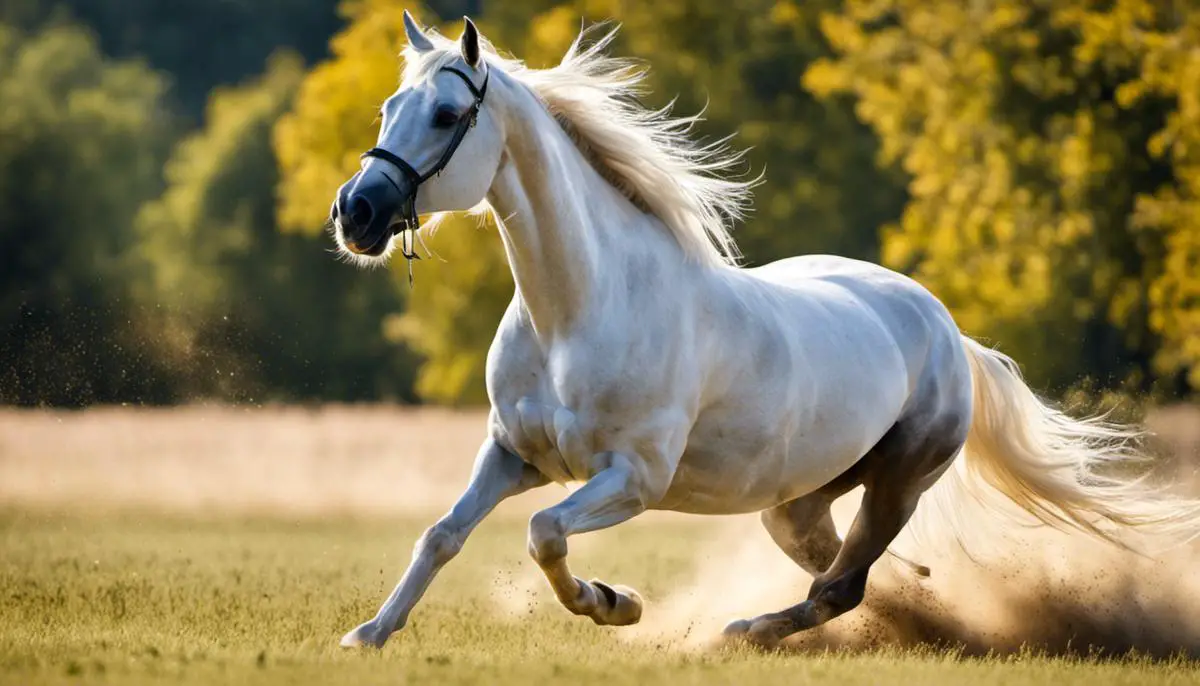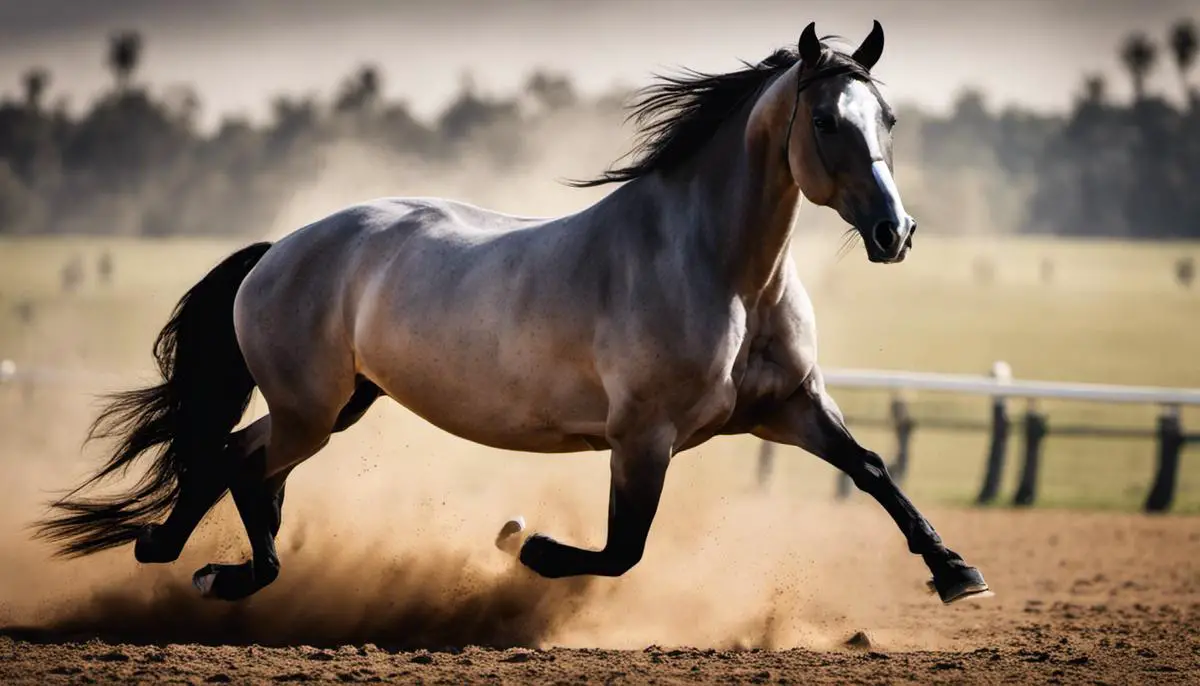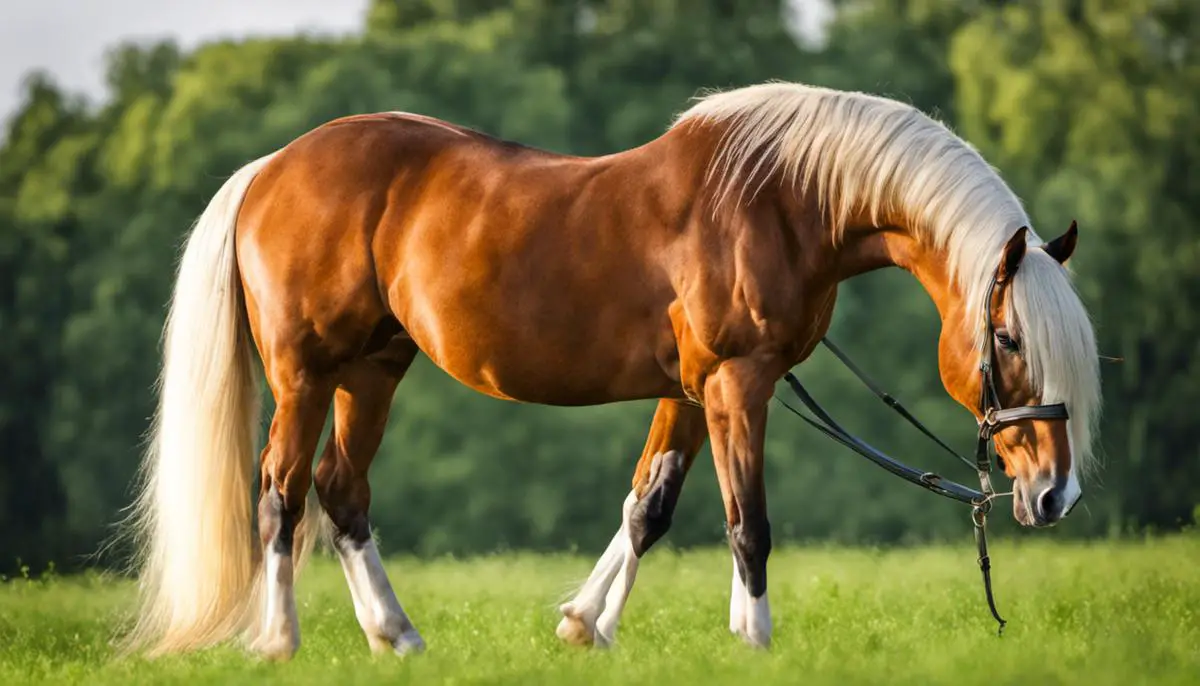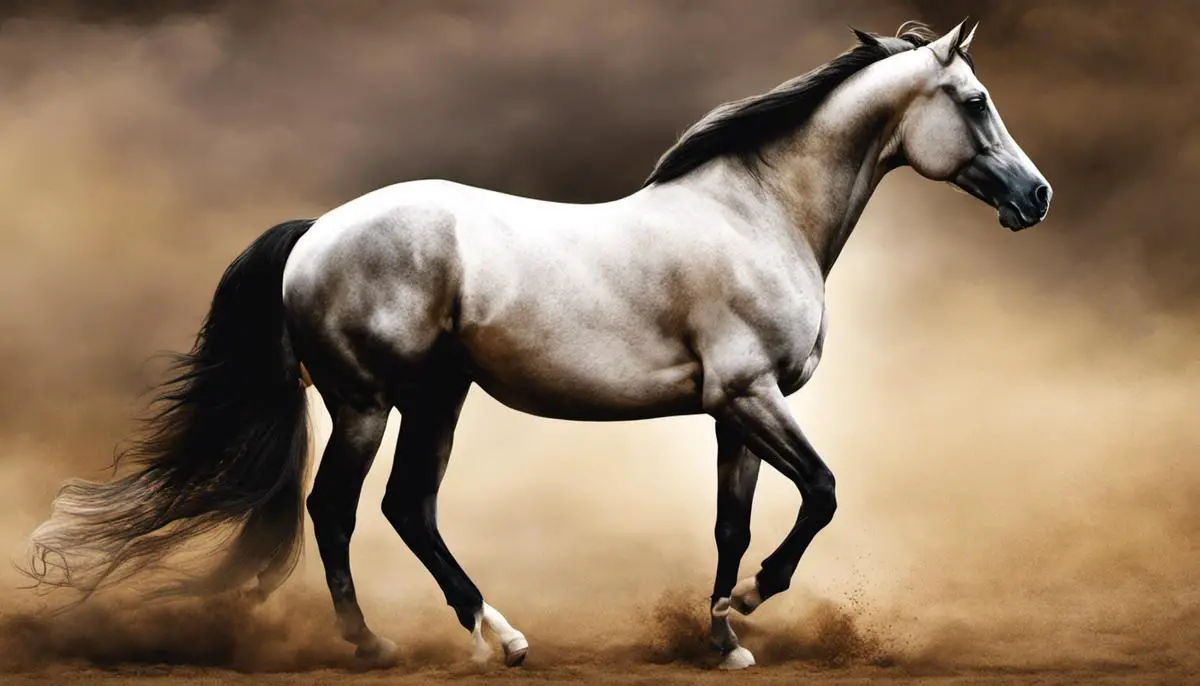The Shagya Arabian is a horse breed with a rich and fascinating history, forged through centuries of selective breeding, war, and the shifting tides of human society. Originating from Arabia, the breed has achieved international renown for its distinct physical characteristics and exceptional performance in various equestrian sports and shows. The Shagya Arabian stands as a testament to humanity’s enduring relationship with horses, a relationship that has shaped not just the breed, but the world around it. This piece aims to enlighten readers about the extraordinary journey of the Shagya Arabian, its breed standards, performance in sports, and how the care and nurturing of the breed are managed.
Table of Contents (Horspedia)
History of Shagya Arabian
Origins of Shagya Arabian
The Shagya Arabian originated in the 19th century, from the Austro-Hungarian Empire’s state stud farm known as the Bábolna Stud. The stud farm, founded in 1789 on the lands of Hungary, aimed to create a hardy, versatile breed that could carry heavy weights over long distances for the military. The Shagya Arabian gets its name from its foundation sire, an impressive gray Arabian stallion named Shagya, who was an Arabian-Syrian horse imported in 1836 for the purpose of refining existing stock.
Historical Evolution of Shagya Arabian
The breed’s initial development was based on Arabian and Turkish horses, selectively bred for a larger size and greater stamina. The breed was further refined with additions from Thoroughbred, Lipizzaner, and Hungarian stock. The Shagya Arabian went through a tumultuous time during the World War periods with sharp population decline, but dedicated breeders managed to preserve the breed. A breed registry was established in 1971, and a closed studbook policy has been in effect since 1978, allowing only horses of certain pedigrees to be registered as Shagya Arabians.
Characteristics of Shagya Arabian
Shagya Arabians are renowned for their endurance and versatility. They have retained the classic Arabian characteristics: a finely chiseled head, a broad forehead, large eyes, and a compact yet sturdy body. However, these horses are generally larger than the desert-bred Arabian, standing at 15 to 16.2 hands high on average. Known for their calm and trainable temperament, they exhibit great stamina, soundness, and robustness.
Role in the Equine World
Shagya Arabians have made a significant impact in the equine world. They have enriched many other breeds, such as the Lipizzaner, the Anglo-Arabian, and various Warmblood breeds. Their prowess in endurance events is lauded, and they make excellent sport horses, suitable for jumping, dressage, and cross-country. Shagya Arabians are also used as working and riding horses for their calm disposition, hardiness, and versatility.
Shagya Arabian: Preservation Efforts
The Shagya Arabian, a unique horse breed, continues to be the focus of dedicated preservation efforts. Recognized for its distinct characteristics, selective breeding programs are currently in place to uphold these unique aspects. A key player in this initiative is the International Shagya-Arabian Society, among many others worldwide, who works tirelessly to promote and safeguard this special breed. Key to their agenda is the regulation of breeding and registration practices, with a unique focus on maintaining genetic diversity, while ensuring the preservation of the versatile and unique features of the Shagya Arabian.

Breed and Conformation Standards
An Introductory Study on the Shagya Arabian Breed
Originating back to the 19th Century from the Austro-Hungarian Empire, the Shagya Arabian stands out from other horse breeds. Its distinguishing traits include vigor, stamina, adaptability, and an unparalleled proclivity for endurance riding. Originally bred for military and agricultural uses, this remarkable horse breed showcases an impressive performance record that continues to captivate enthusiasts worldwide.
Physical Characteristics & Conformation
Shagya Arabians are renowned for their impressive physical attributes. They typically stand between 14.2 to 16 hands high (approximately 57 to 64 inches at the shoulder), and their weight varies between 900 to 1,300 pounds. Despite this substantial weight, Shagya Arabians are noted for their athletic frames and agility. Their bodies demonstrate strength without excessive bulk, which helps in their renowned stamina and speed.
Their heads are medium in size and often have a straight or slightly convex profile, with large, expressive eyes. They possess a well-carved neck that’s harmoniously aligned with their bodies. Shagya Arabians typically have long legs with broad joints and hard hooves, which contribute to their speed and durability.
The breed’s coat colors are predominantly grey and bay, but chestnut, black, and roan can also be seen, although they’re less common. The coat of these magnificent creatures is typically dense and shiny indicating good health and vitality.
Temperament
In addition to their physical prowess, Shagya Arabians are highly prized for their temperament. They are described as being calm, trainable, and intelligent, making them ideal horses for both competition and recreational riding. Despite their active nature, these horses possess a balanced temperament which endears them to riders of all experience levels.
These horses are known for their sensible and cooperative nature, and their willingness to please their handlers. This makes them particularly useful for a variety of equestrian pursuits from dressage and show-jumping to trail-riding and other equestrian sports.
Unique Features
What makes Shagya Arabians particularly unique, apart from their physical and temperament characteristics, are their ability to perform in challenging terrains and their longer strides, a trait well-favored in endurance races. The breed’s versatility, endurance, and toughness are highly valued, enabling them to excel in various equestrian disciplines and tasks.
Conclusion
The Shagya Arabian stands out due to its unique physical attributes and temperament. These striking features, in conjunction with its historical significance and remarkable versatility in diverse equine pursuits, have earned this breed the admiration of both horse enthusiasts and equestrian professionals.

Shagya Arabian in Sport and Show
The Shagya Arabian’s Role in Equestrian Sports
With its robust stature, superior endurance, and remarkable agility, the Shagya Arabian is a notable figure in various equestrian sports. Its ability to excel in everything from eventing to dressage and show jumping makes it a popular choice among competitive riders. Due to their impressive athletic abilities, these horses maintain an esteemed reputation for their skills and multi-faceted performances.
Eventing: A Test of All-Round Ability
In the world of eventing, a sport that combines dressage, cross-country, and show jumping, Shagya Arabians prove their worth by excelling on all fronts. The breed’s stamina, speed, and jumping ability shine in the cross-country phase, while their elegance and precision come to the fore in dressage and show jumping. The fact that they can master all these disciplines speaks volumes about their adaptability and athleticism.
Dressage: Showcasing Elegance and Control
In dressage, a sport requiring a high degree of synchronization between horse and rider, Shagya Arabians are highly revered. Their ability to perform complex movements with grace and precision is a testament to their intelligence and trainability. They excel in these competitions due to their natural rhythm, balance, and ability to respond to subtle cues from the rider.
Show Jumping: Leaping to New Heights
The agility of Shagya Arabians is notably showcased in show jumping, where they brilliantly navigate through a course with tight turns, triple combinations, and high jumps. Their powerful hindquarters enable them to leap with great momentum while maintaining control and precision. Their bold and fearless nature also gives them an edge in this high adrenaline sport.
Endurance Racing: Demonstrating Stamina and Speed
The Shagya Arabian horse breed is also renowned for its phenomenal performance in endurance races. The breed’s great stamina, stemming from their desert heritage, combined with their natural speed, makes them strong contenders in these long-distance races. Their ability to maintain a steady pace over extensive distances and challenging terrains is remarkable.
Versatility in Show and Pleasure Riding
Shagya Arabians are also highly versatile, often participating in a variety of other equestrian sports and recreational activities such as pleasure riding, trail riding, and competitive driving. Moreover, their gentle temperament and intelligence make them a joy to work with, granting them popularity not just in competitive fields, but also as leisure horses.
Excelling in Performance: The Award-Winning Shagya Arabians
The unmistakable capabilities of Shagya Arabians have not only set them apart but have also earned them numerous awards and accolades worldwide. These majestic horses have consistently performed excellently with riders clinching victories in both national and international arenas. They owe their individuality and distinction to a unique combination of sport-aptitude and unmistakable demeanor, making them a standout breed indeed.

Caring for a Shagya Arabian
Nurturing Health: Tailoring Nutrition for Shagya Arabians
Propelling the excellent performance of Shagya Arabians is a nutritional regimen that is meticulously crafted and balanced. Similar to other horse breeds, Shagya Arabians require a diet abundant in top-notch forage such as hay or pasture, and supplemented by grain. It’s vital for their food intake to strike a balance in terms of fiber for efficient digestion. Their grain intake, which can include oats, corn, or barley, is adjusted based on their age, health condition, and level of activity. Ultimately, holistic horse nutrition lies in achieving the optimum balance of protein, fat, vitamins, and minerals. Specific nutritional recommendations tailored to individual horses can be obtained from an equine nutrition specialist or a qualified veterinarian.
Routine Health Checkups For Shagya Arabian
Shagya Arabians need regular health checkups. Routine veterinary visits can help in preventing and identifying potential health issues early. Regular deworming and vaccinations against equine diseases are recommended. Dental checkups are also crucial, as tooth problems may affect the horse’s ability to chew food properly, leading to nutritional deficiencies.
Shagya Arabian Grooming Needs
Grooming for a Shagya Arabian goes beyond aesthetic value. It promotes healthier skin by stimulating blood flow and distributing natural oils across the horse’s coat. Grooming sessions also offer an opportunity to check for injuries, parasites, or skin conditions that might need attention. These horses should have their feet cleaned regularly to prevent hoof diseases, and they may require shoeing depending on the type of work they do.
Specific Needs of Shagya Arabian
Shagya Arabians are dynamic and versatile horses known for their stamina and endurance. As such, they require regular exercise to maintain their physical fitness and mental wellbeing. Shagya Arabians are also known for their friendly and calm nature, and they thrive on social interaction. Providing them with companionship, either human or equine, can go a long way in ensuring their overall health and happiness.
Common Health Problems in Shagya Arabian
Shagya Arabians are generally robust and healthy, but they can be prone to certain health problems like other horse breeds. Common issues include equine gastric ulcer syndrome (EGUS), laminitis, and certain respiratory conditions. Regular veterinary care and proper management practices can help prevent these conditions or manage them if they do occur. For instance, a proper diet can reduce the risk of EGUS and laminitis, while providing a dust-free environment can help prevent respiratory issues.
Shagya Arabian: A Symbol of Care and Affection
Maintaining the health and welfare of a Shagya Arabian involves a combination of proper nutrition, regular health checks, appropriate grooming, meeting specific needs tailored to their breed, and early identification of health problems. By taking such measures, these horses can lead a healthy, thriving life, which mirrors the care and affection they are given.

Embodying a remarkable combination of grace, strength, and tenacity, Shagya Arabians have certainly charted a distinctive course in the world of equine breeds. From their roots in Arabian peninsula to their growing presence in the international equestian stage, these horses have demonstrated not just physical prowess, but an adaptable spirit. The successful preservation and care of the Shagya Arabian also attests to the dedicated efforts of breeders, veterinarians, and horse-enthusiasts worldwide. As the Shagya Arabian continues to gallop into the future, its journey serves as a poignant reminder of the timeless and mutually transformative bond between humanity and horses.

